Click to join the conversation with over 500,000 Pentecostal believers and scholars
Click to get our FREE MOBILE APP and stay connected
| PentecostalTheology.com



In U.S., Decline of Christianity Continues at Rapid Pace
An update on America’s changing religious landscape
The religious landscape of the United States continues to change at a rapid clip. In Pew Research Center telephone surveys conducted in 2018 and 2019, 65% of American adults describe themselves as Christians when asked about their religion, down 12 percentage points over the past decade. Meanwhile, the religiously unaffiliated share of the population, consisting of people who describe their religious identity as atheist, agnostic or “nothing in particular,” now stands at 26%, up from 17% in 2009.
Both Protestantism and Catholicism are experiencing losses of population share. Currently, 43% of U.S. adults identify with Protestantism, down from 51% in 2009. And one-in-five adults (20%) are Catholic, down from 23% in 2009. Meanwhile, all subsets of the religiously unaffiliated population – a group also known as religious “nones” – have seen their numbers swell. Self-described atheists now account for 4% of U.S. adults, up modestly but significantly from 2% in 2009; agnostics make up 5% of U.S. adults, up from 3% a decade ago; and 17% of Americans now describe their religion as “nothing in particular,” up from 12% in 2009. Members of non-Christian religions also have grown modestly as a share of the adult population.
These are among the key findings of a new analysis of trends in the religious composition and churchgoing habits of the American public, based on recent Pew Research Center random-digit-dial (RDD) political polling on the telephone.1 The data shows that the trend toward religious disaffiliation documented in the Center’s 2007 and 2014 Religious Landscape Studies, and before that in major national studies like the General Social Survey (GSS), has continued apace.
Pew Research Center’s 2007 and 2014 Religious Landscape Studies were huge national RDD surveys, each of which included interviews with more than 35,000 respondents who were asked dozens of detailed questions about their religious identities, beliefs and practices. The Center has not yet conducted a third such study, and when the Landscape Study is repeated, it is likely to use new methods that may prevent it from being directly comparable to the previous studies; growing challenges to conducting national surveys by telephone have led the Center to rely increasingly on self-administered surveys conducted online.2
But while no new Religious Landscape Study is available or in the immediate offing, the Center has collected five additional years of data (since the 2014 Landscape Study) from RDD political polls (see detailed tables). The samples from these political polls are not as large as the Landscape Studies (even when all of the political polls conducted in a year are combined), but together, 88 surveys from 2009 to 2019 included interviews with 168,890 Americans.
These surveys do not include nearly as many questions about religion as the Landscape Studies do. However, as part of the demographic battery of questions that ask respondents about their age, race, educational attainment and other background characteristics, each of these political polls also include one basic question about religious identity – “What is your present religion, if any? Are you Protestant, Roman Catholic, Mormon, Orthodox such as Greek or Russian Orthodox, Jewish, Muslim, Buddhist, Hindu, atheist, agnostic, something else, or nothing in particular?”
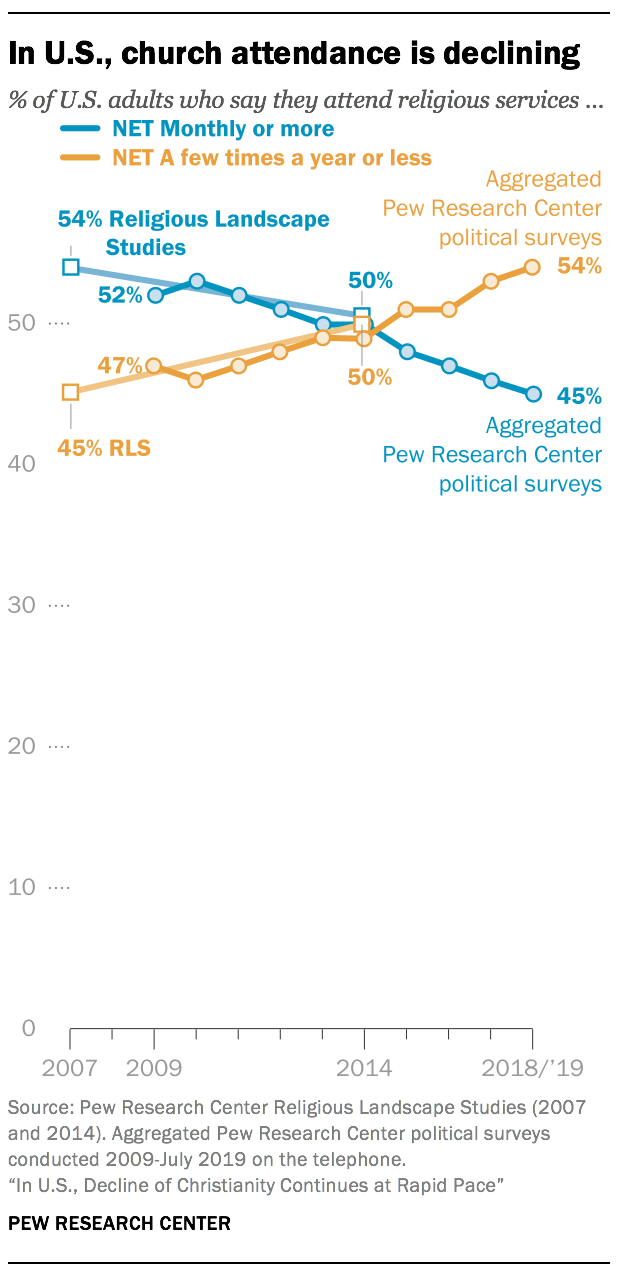 Additionally, most of these political polls include a question about religious attendance – “Aside from weddings and funerals, how often do you attend religious services? More than once a week, once a week, once or twice a month, a few times a year, seldom, or never?” Taken together, these two questions (one about religious identity, the other about religious attendance) can help shed light on religious trends in the U.S.
Additionally, most of these political polls include a question about religious attendance – “Aside from weddings and funerals, how often do you attend religious services? More than once a week, once a week, once or twice a month, a few times a year, seldom, or never?” Taken together, these two questions (one about religious identity, the other about religious attendance) can help shed light on religious trends in the U.S.
The data shows that just like rates of religious affiliation, rates of religious attendance are declining.3 Over the last decade, the share of Americans who say they attend religious services at least once or twice a month dropped by 7 percentage points, while the share who say they attend religious services less often (if at all) has risen by the same degree. In 2009, regular worship attenders (those who attend religious services at least once or twice a month) outnumbered those who attend services only occasionally or not at all by a 52%-to-47% margin. Today those figures are reversed; more Americans now say they attend religious services a few times a year or less (54%) than say they attend at least monthly (45%).
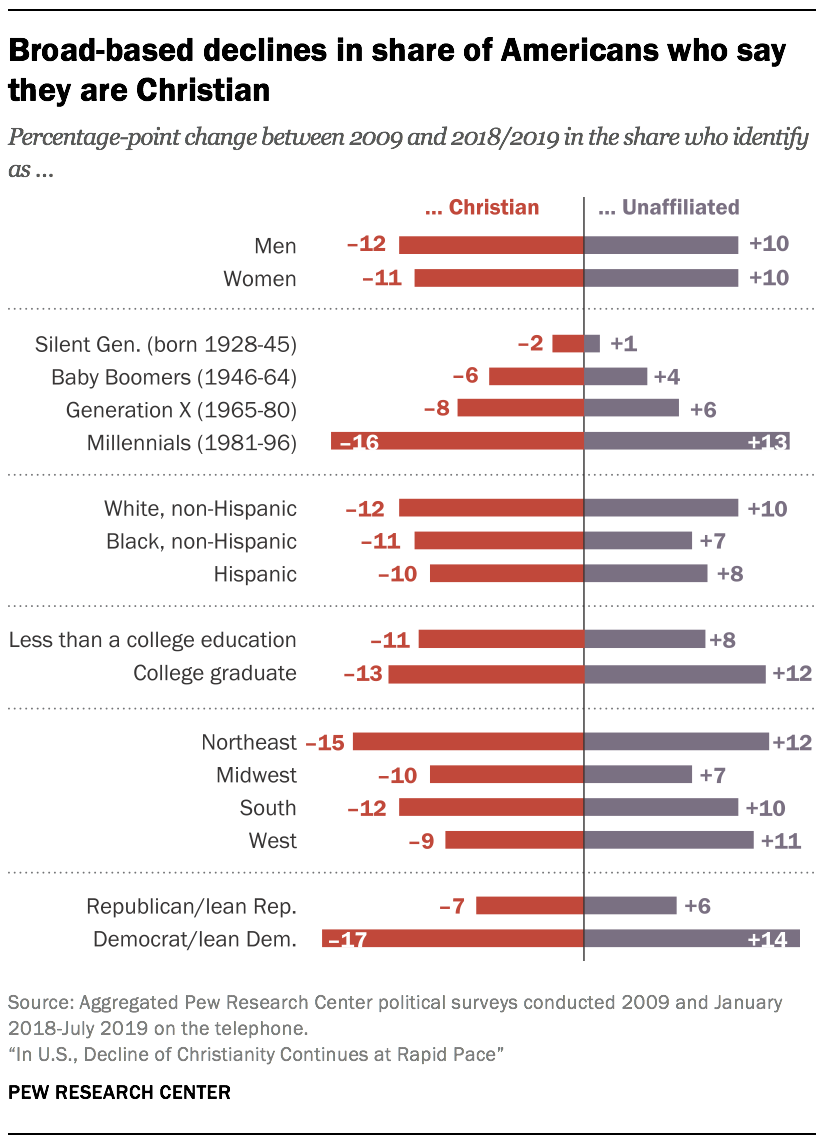 The changes underway in the American religious landscape are broad-based. The Christian share of the population is down and religious “nones” have grown across multiple demographic groups: white people, black people and Hispanics; men and women; in all regions of the country; and among college graduates and those with lower levels of educational attainment. Religious “nones” are growing faster among Democrats than Republicans, though their ranks are swelling in both partisan coalitions. And although the religiously unaffiliated are on the rise among younger people and most groups of older adults, their growth is most pronounced among young adults.
The changes underway in the American religious landscape are broad-based. The Christian share of the population is down and religious “nones” have grown across multiple demographic groups: white people, black people and Hispanics; men and women; in all regions of the country; and among college graduates and those with lower levels of educational attainment. Religious “nones” are growing faster among Democrats than Republicans, though their ranks are swelling in both partisan coalitions. And although the religiously unaffiliated are on the rise among younger people and most groups of older adults, their growth is most pronounced among young adults.
Furthermore, the data shows a wide gap between older Americans (Baby Boomers and members of the Silent Generation) and Millennials in their levels of religious affiliation and attendance. More than eight-in-ten members of the Silent Generation (those born between 1928 and 1945) describe themselves as Christians (84%), as do three-quarters of Baby Boomers (76%). In stark contrast, only half of Millennials (49%) describe themselves as Christians; four-in-ten are religious “nones,” and one-in-ten Millennials identify with non-Christian faiths.
Only about one-in-three Millennials say they attend religious services at least once or twice a month. Roughly two-thirds of Millennials (64%) attend worship services a few times a year or less often, including about four-in-ten who say they seldom or never go. Indeed, there are as many Millennials who say they “never” attend religious services (22%) as there are who say they go at least once a week (22%).
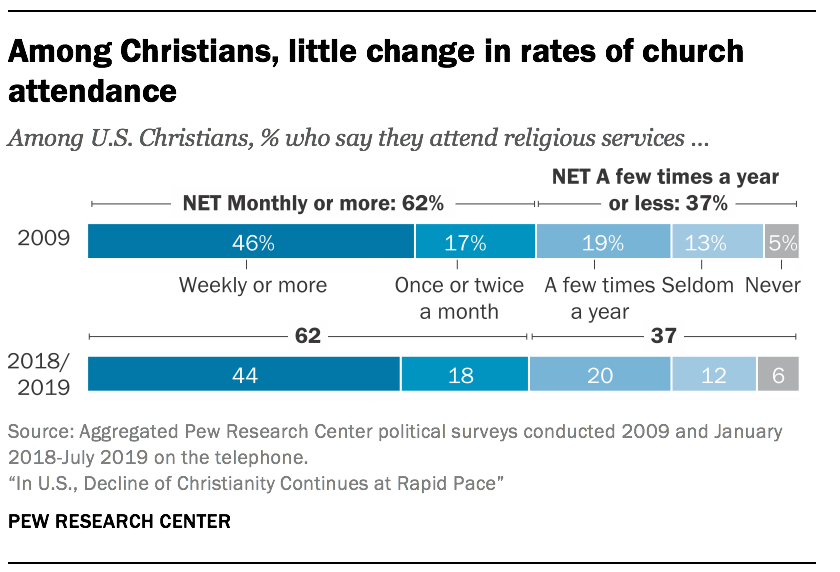 While the trends are clear – the U.S. is steadily becoming less Christian and less religiously observant as the share of adults who are not religious grows – self-described Christians report that they attend religious services at about the same rate today as in 2009. Today, 62% of Christians say they attend religious services at least once or twice a month, which is identical to the share who said the same in 2009. In other words, the nation’s overall rate of religious attendance is declining not because Christians are attending church less often, but rather because there are now fewer Christians as a share of the population.
While the trends are clear – the U.S. is steadily becoming less Christian and less religiously observant as the share of adults who are not religious grows – self-described Christians report that they attend religious services at about the same rate today as in 2009. Today, 62% of Christians say they attend religious services at least once or twice a month, which is identical to the share who said the same in 2009. In other words, the nation’s overall rate of religious attendance is declining not because Christians are attending church less often, but rather because there are now fewer Christians as a share of the population.
Other key takeaways from the new analysis include:
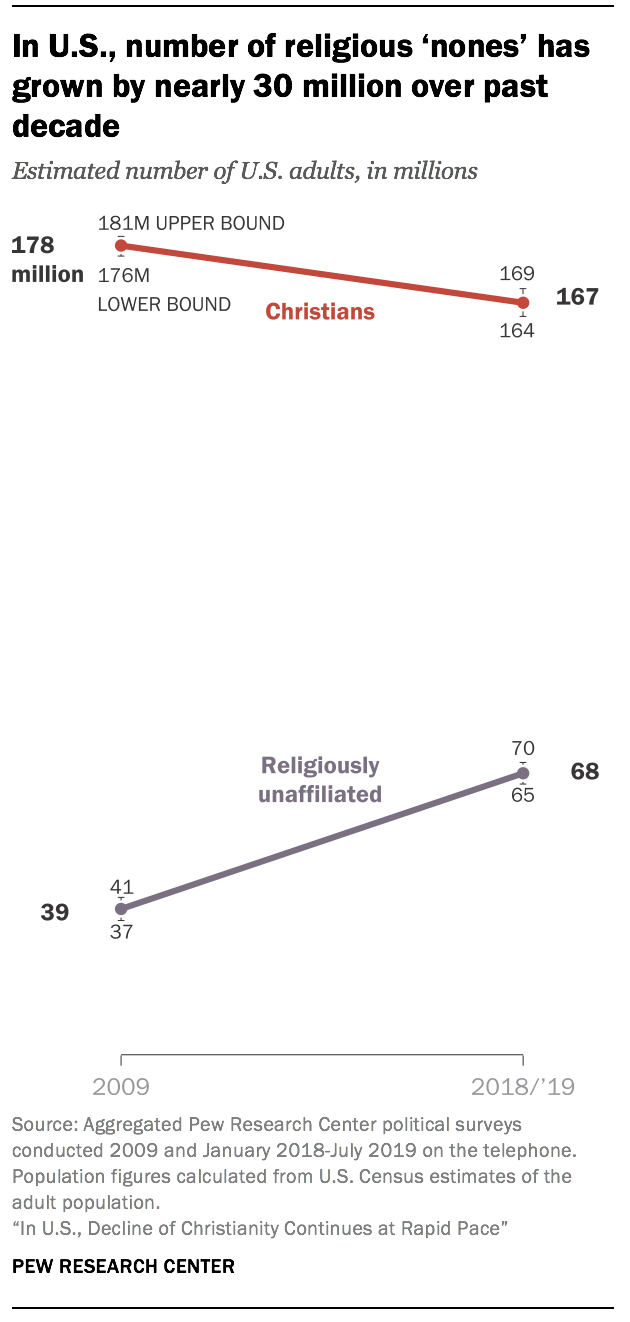 The data suggests that Christians are declining not just as a share of the U.S. adult population, but also in absolute numbers. In 2009, there were approximately 233 million adults in the U.S., according to the Census Bureau. Pew Research Center’s RDD surveys conducted at the time indicated that 77% of them were Christian, which means that by this measure, there were approximately 178 million Christian adults in the U.S. in 2009. Taking the margin of error of the surveys into account, the number of adult Christians in the U.S. as of 2009 could have been as low as 176 million or as high as 181 million.
The data suggests that Christians are declining not just as a share of the U.S. adult population, but also in absolute numbers. In 2009, there were approximately 233 million adults in the U.S., according to the Census Bureau. Pew Research Center’s RDD surveys conducted at the time indicated that 77% of them were Christian, which means that by this measure, there were approximately 178 million Christian adults in the U.S. in 2009. Taking the margin of error of the surveys into account, the number of adult Christians in the U.S. as of 2009 could have been as low as 176 million or as high as 181 million.
Today, there are roughly 23 million more adults in the U.S. than there were in 2009 (256 million as of July 1, 2019, according to the Census Bureau). About two-thirds of them (65%) identify as Christians, according to 2018 and 2019 Pew Research Center RDD estimates. This means that there are now roughly 167 million Christian adults in the U.S. (with a lower bound of 164 million and an upper bound of 169 million, given the survey’s margin of error).
Meanwhile, the number of religiously unaffiliated adults in the U.S. grew by almost 30 million over this period.
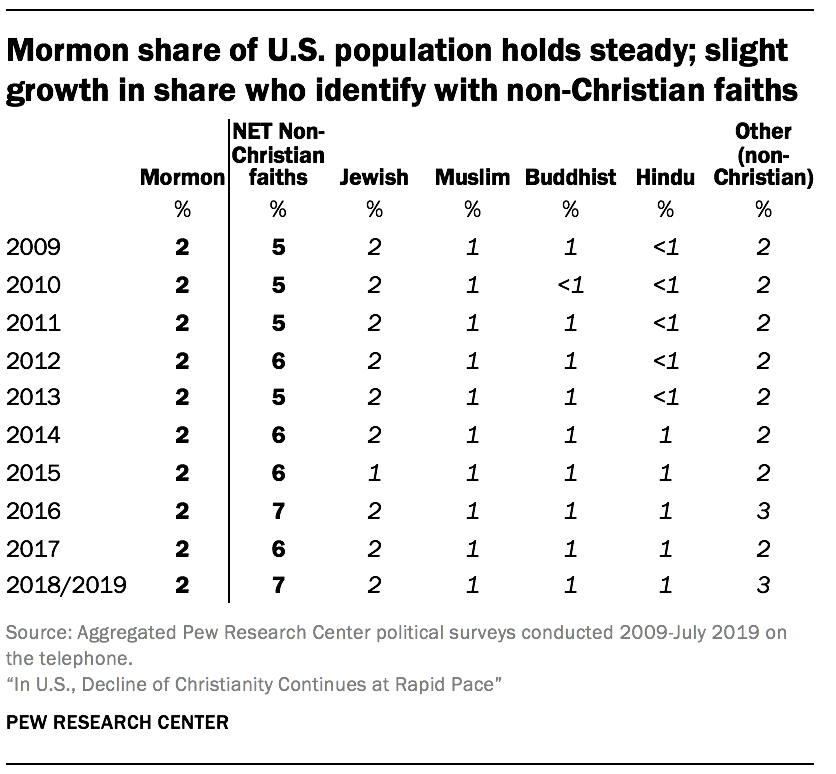 The share of Americans who describe themselves as Mormons has held steady at 2% over the past decade.4 Meanwhile, the share of U.S. adults who identify with non-Christian faiths has ticked up slightly, from 5% in 2009 to 7% today. This includes a steady 2% of Americans who are Jewish, along with 1% who are Muslim, 1% who are Buddhist, 1% who are Hindu, and 3% who identify with other faiths (including, for example, people who say they abide by their own personal religious beliefs and people who describe themselves as “spiritual”)5
The share of Americans who describe themselves as Mormons has held steady at 2% over the past decade.4 Meanwhile, the share of U.S. adults who identify with non-Christian faiths has ticked up slightly, from 5% in 2009 to 7% today. This includes a steady 2% of Americans who are Jewish, along with 1% who are Muslim, 1% who are Buddhist, 1% who are Hindu, and 3% who identify with other faiths (including, for example, people who say they abide by their own personal religious beliefs and people who describe themselves as “spiritual”)5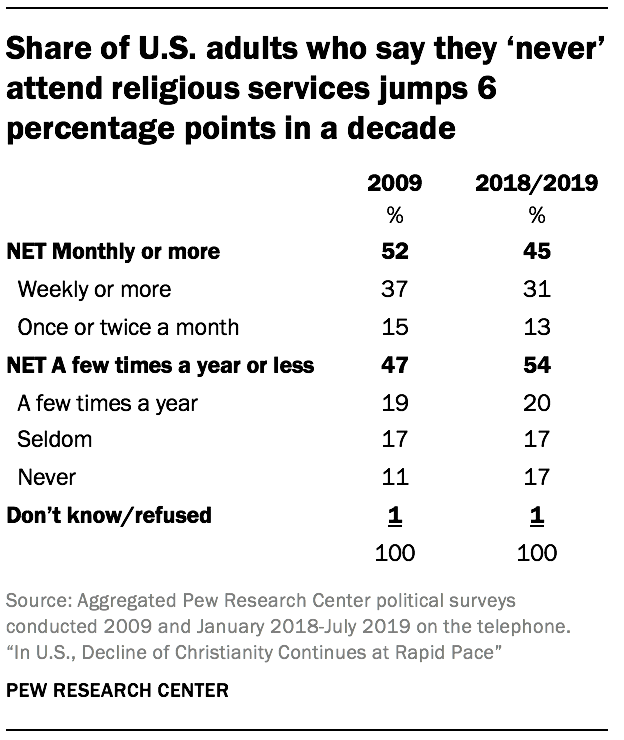 The rising share of Americans who say they attend religious services no more than a few times a year (if at all) has been driven by a substantial jump in the proportion who say they “never” go to church. Today, 17% of Americans say they never attend religious services, up from 11% a decade ago. Similarly, the decline in regular churchgoing is attributable mainly to the shrinking share of Americans who say they attend religious services at least once a week, which was 37% in 2009 and now stands at 31%.
The rising share of Americans who say they attend religious services no more than a few times a year (if at all) has been driven by a substantial jump in the proportion who say they “never” go to church. Today, 17% of Americans say they never attend religious services, up from 11% a decade ago. Similarly, the decline in regular churchgoing is attributable mainly to the shrinking share of Americans who say they attend religious services at least once a week, which was 37% in 2009 and now stands at 31%.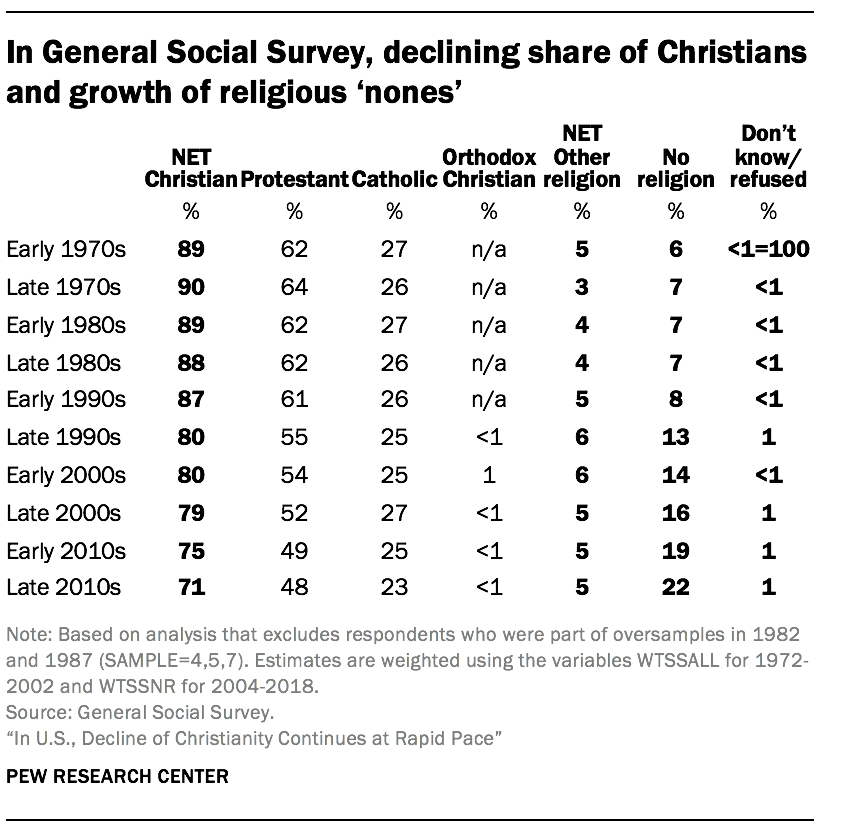 The trends documented in Pew Research Center surveys closely resemble those found in the long-running General Social Survey (GSS), a project of the independent research organization NORC at the University of Chicago, with principal funding from the National Science Foundation. In GSS surveys conducted in the early 2000s (2000 to 2004), 80% of U.S. adults identified as Christians, including 54% who described themselves as Protestants and 25% who were Catholic. By the late 2010s, 71% of GSS respondents described themselves as Christians (48% Protestant, 23% Catholic). Over the same period, the GSS found that religious “nones” grew from 14% of the U.S. adult population to 22%.
The trends documented in Pew Research Center surveys closely resemble those found in the long-running General Social Survey (GSS), a project of the independent research organization NORC at the University of Chicago, with principal funding from the National Science Foundation. In GSS surveys conducted in the early 2000s (2000 to 2004), 80% of U.S. adults identified as Christians, including 54% who described themselves as Protestants and 25% who were Catholic. By the late 2010s, 71% of GSS respondents described themselves as Christians (48% Protestant, 23% Catholic). Over the same period, the GSS found that religious “nones” grew from 14% of the U.S. adult population to 22%.
The point estimates from the GSS and Pew Research Center surveys (that is, the share of adults who identify as Protestant or Catholic or as religious “nones”) are not directly comparable; the two studies ask different questions and employ different modes of survey administration. But the fact that the direction of the trend is similar in both studies strongly suggests that both are picking up on real and significant change underway in the U.S. religious landscape.
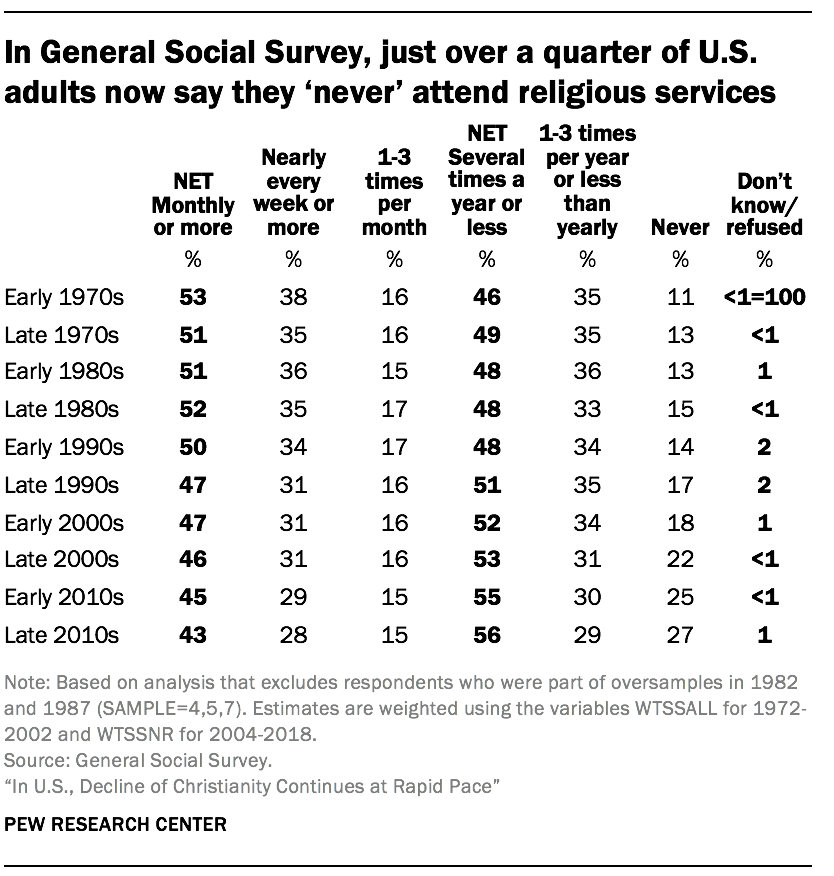 Similarly, the GSS finds that a declining share of U.S. adults say they attend religious services regularly. In the most recent GSS studies, 43% of respondents say they attend religious services at least monthly, down from 47% in the early 2000s and 50% in the early 1990s. Meanwhile, the share of U.S. adults who say they “never” attend religious services now stands at 27%, up from 18% in the early 2000s and roughly double the share who said this in the early 1990s (14%).
Similarly, the GSS finds that a declining share of U.S. adults say they attend religious services regularly. In the most recent GSS studies, 43% of respondents say they attend religious services at least monthly, down from 47% in the early 2000s and 50% in the early 1990s. Meanwhile, the share of U.S. adults who say they “never” attend religious services now stands at 27%, up from 18% in the early 2000s and roughly double the share who said this in the early 1990s (14%).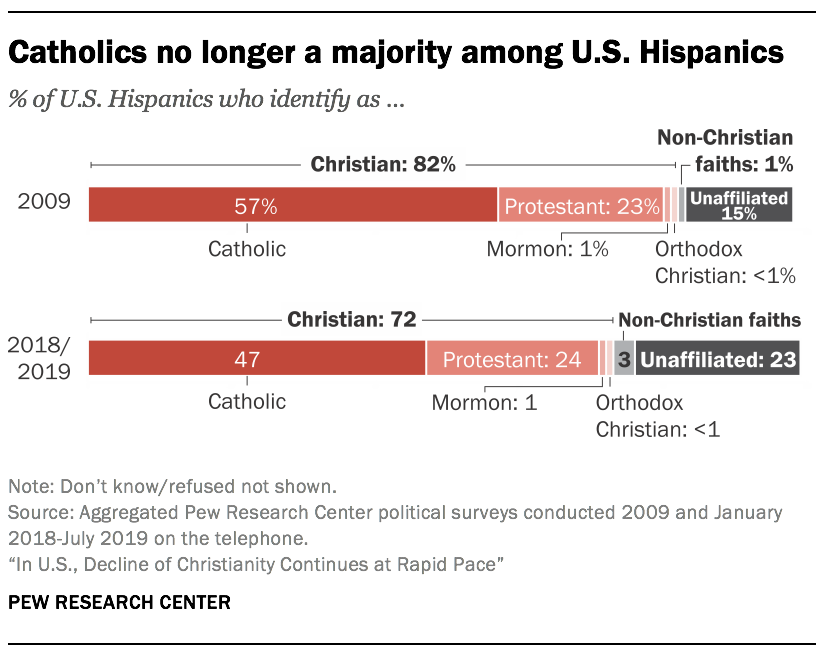 Catholics no longer constitute a majority of the U.S. Hispanic population. In Pew Research Center RDD surveys conducted in 2018 and 2019, 47% of Hispanics describe themselves as Catholic, down from 57% a decade ago. Meanwhile, the share of Hispanics who say they are religiously unaffiliated is now 23%, up from 15% in 2009.
Catholics no longer constitute a majority of the U.S. Hispanic population. In Pew Research Center RDD surveys conducted in 2018 and 2019, 47% of Hispanics describe themselves as Catholic, down from 57% a decade ago. Meanwhile, the share of Hispanics who say they are religiously unaffiliated is now 23%, up from 15% in 2009.
These findings about the religious composition of Hispanics closely resemble those from Pew Research Center’s National Surveys of Latinos (NSL) – a nationally representative survey of U.S. Latino adults fielded almost every year. (See the detailed tables for complete trends in the religious composition of Hispanics based on both Pew Research Center political surveys and the NSL.)
 Among white adults, the share of people who say they attend religious services a few times a year or less now exceeds the share who attend monthly or more (57% vs. 42%); a decade ago, the white population was evenly divided between those who went to church at least monthly and those who did not. Regular churchgoers still outnumber those who infrequently or never go to religious services among black Americans (58% vs. 41%), though the share of people who say they attend religious services a few times a year or less often has risen over the last decade among black Americans, just as it has among the population as a whole. U.S. Hispanics are now about evenly divided between those who say they attend religious services at least once or twice a month (51%) and those who say they attend a few times a year or less (49%).
Among white adults, the share of people who say they attend religious services a few times a year or less now exceeds the share who attend monthly or more (57% vs. 42%); a decade ago, the white population was evenly divided between those who went to church at least monthly and those who did not. Regular churchgoers still outnumber those who infrequently or never go to religious services among black Americans (58% vs. 41%), though the share of people who say they attend religious services a few times a year or less often has risen over the last decade among black Americans, just as it has among the population as a whole. U.S. Hispanics are now about evenly divided between those who say they attend religious services at least once or twice a month (51%) and those who say they attend a few times a year or less (49%).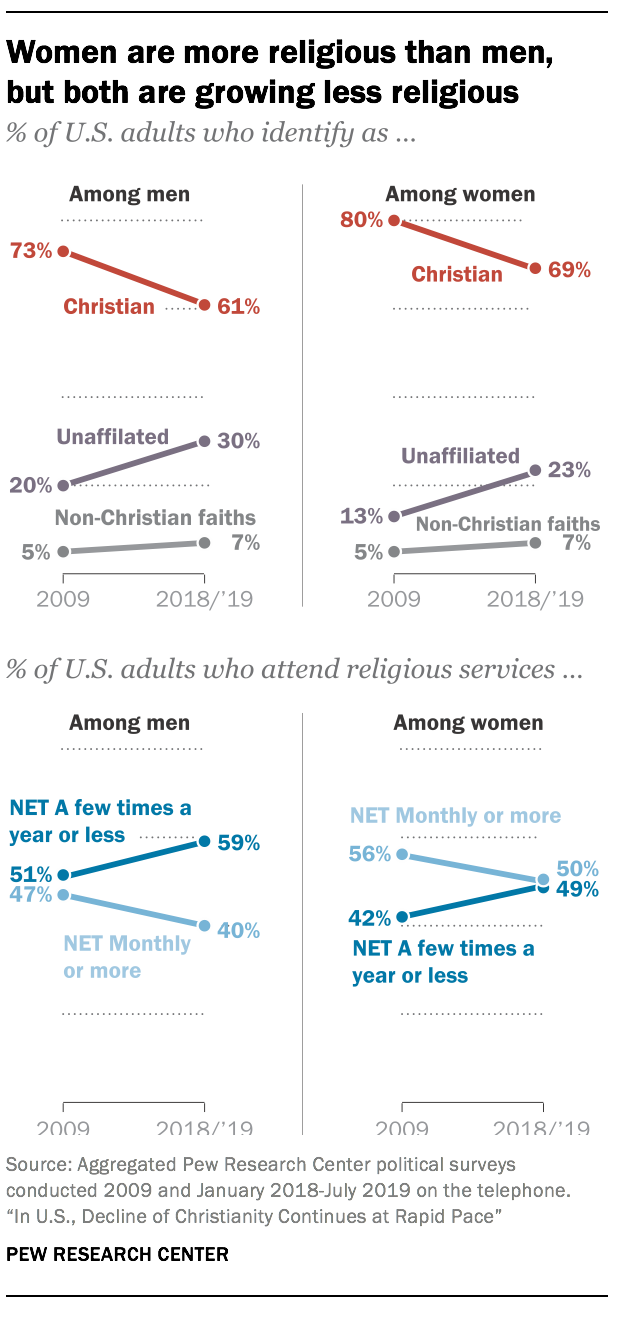 There is still a gender gap in American religion. Women are less likely than men to describe themselves as religious “nones” (23% vs. 30%), and more likely than men to say they attend religious services at least once or twice a month (50% vs. 40%). But women, like men, have grown noticeably less religious over the last decade. The share of “nones” among women has risen by 10 percentage points since 2009 – similar to the increase among men. And the share of women who identify as Christian has fallen by 11 points (from 80% to 69%) over that same period.
There is still a gender gap in American religion. Women are less likely than men to describe themselves as religious “nones” (23% vs. 30%), and more likely than men to say they attend religious services at least once or twice a month (50% vs. 40%). But women, like men, have grown noticeably less religious over the last decade. The share of “nones” among women has risen by 10 percentage points since 2009 – similar to the increase among men. And the share of women who identify as Christian has fallen by 11 points (from 80% to 69%) over that same period.- Christians have declined and “nones” have grown as a share of the adult population in all four major U.S. regions. Catholic losses have been most pronounced in the Northeast, where 36% identified as Catholic in 2009, compared with 27% today. Among Protestants, declines were larger in the South, where Protestants now account for 53% of the adult population, down from 64% in 2009.
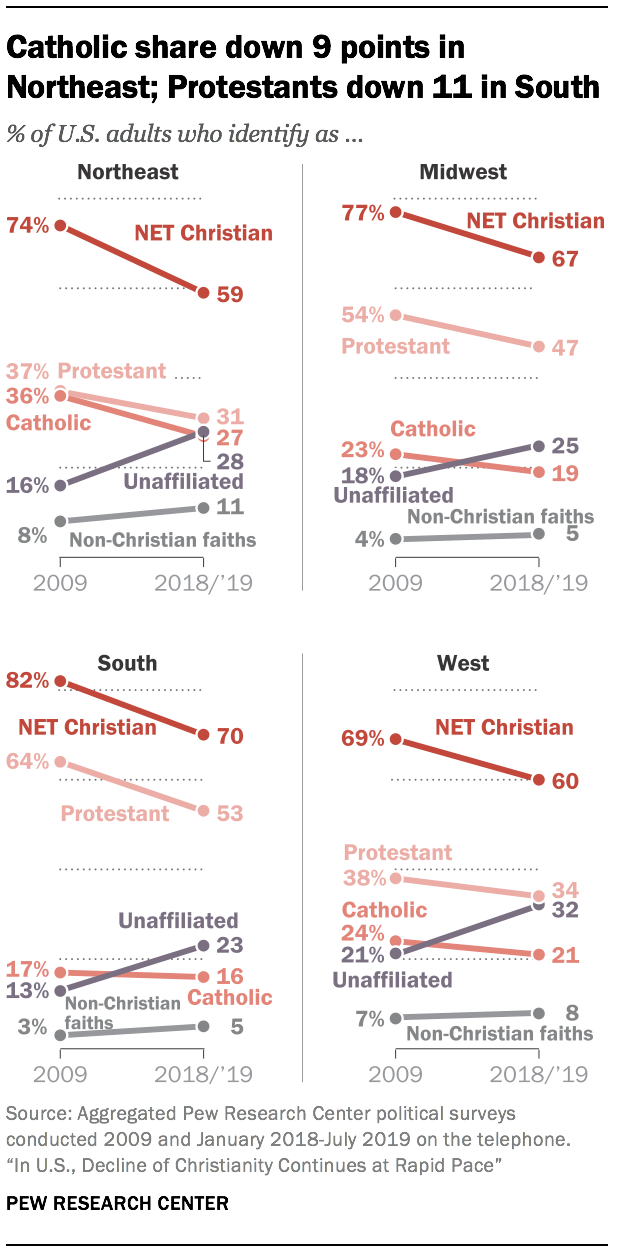
- Religious “nones” now make up fully one-third of Democrats. And about six-in-ten people who identify with or lean toward the Democratic Party say they attend religious services no more than a few times a year. The ranks of religious “nones” and infrequent churchgoers also are growing within the Republican Party, though they make up smaller shares of Republicans than Democrats.

- The religious profile of white Democrats is very different from the religious profile of racial and ethnic minorities within the Democratic Party. Today, fewer than half of white Democrats describe themselves as Christians, and just three-in-ten say they regularly attend religious services. More than four-in-ten white Democrats are religious “nones,” and fully seven-in-ten white Democrats say they attend religious services no more than a few times a year. Black and Hispanic Democrats are far more likely than white Democrats to describe themselves as Christians and to say they attend religious services regularly, though all three groups are becoming less Christian.
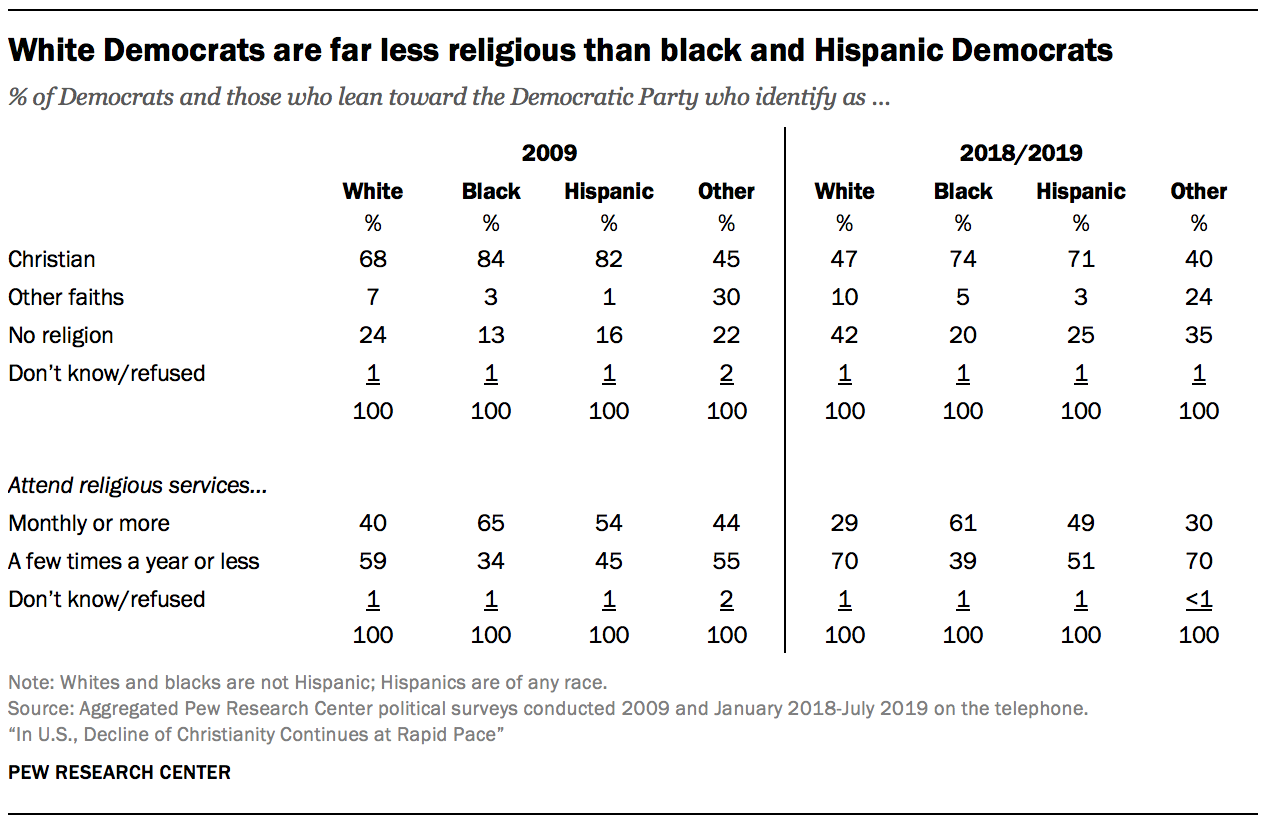
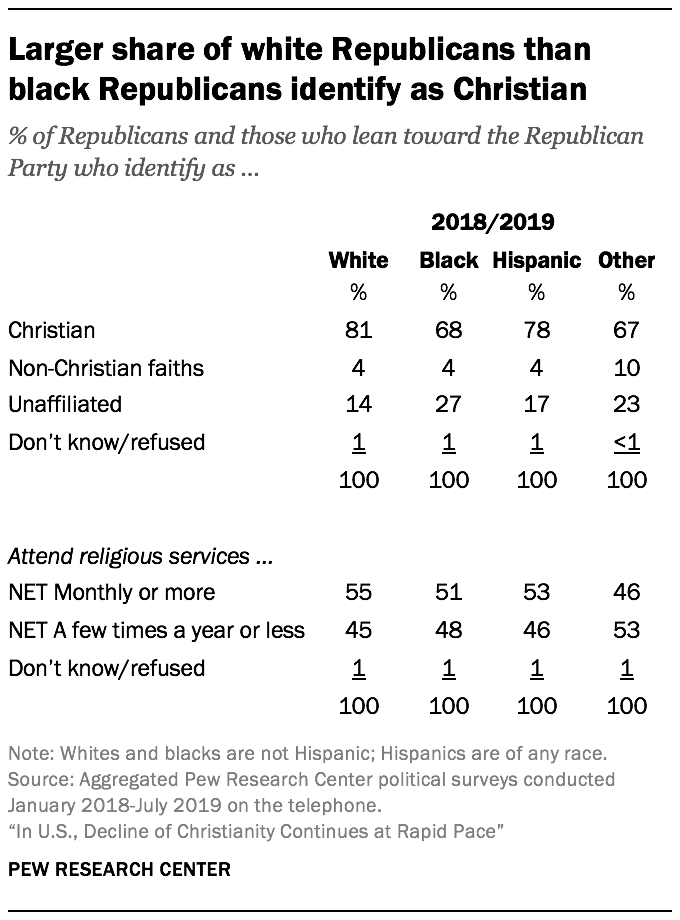 Although 2009 surveys did not include enough black Republicans to analyze separately, the most recent surveys show smaller religious differences by race and ethnicity among Republicans than Democrats.
Although 2009 surveys did not include enough black Republicans to analyze separately, the most recent surveys show smaller religious differences by race and ethnicity among Republicans than Democrats. 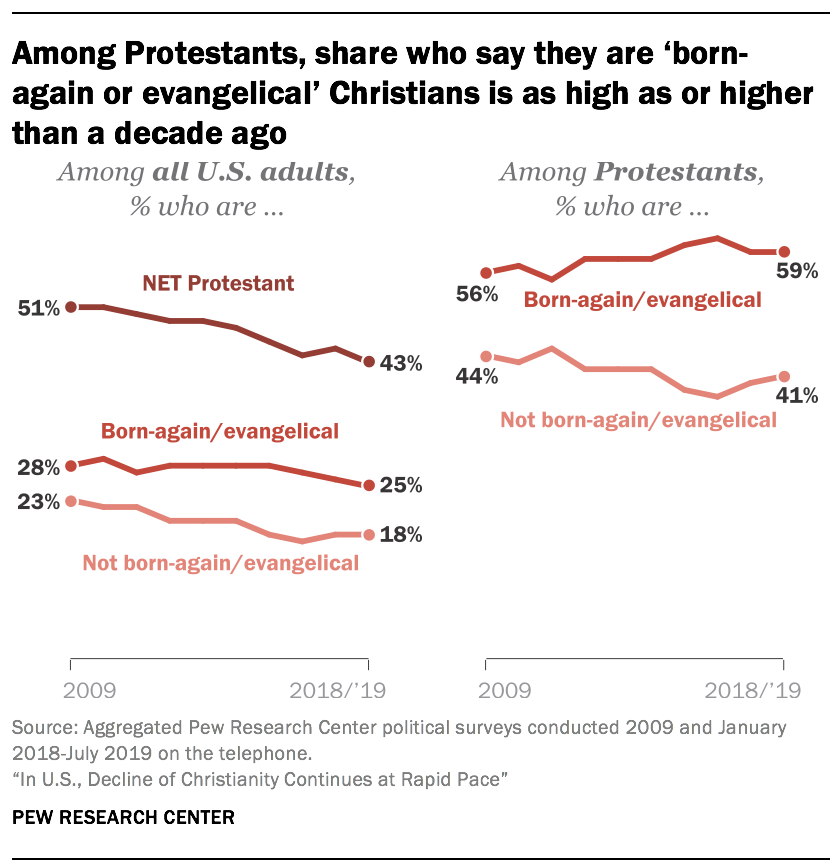 Pew Research Center’s telephone political polls do not typically include the detailed questions that are needed to determine whether Protestants identify with denominations in the evangelical, mainline or historically black Protestant tradition. However, the political polls upon which this analysis is based do ask Protestants whether they think of themselves as “born-again or evangelical” Christians. The data shows that both Protestants who describe themselves as born-again or evangelical Christians and Protestants who are not born-again or evangelical have declined as a share of the overall U.S. adult population, reflecting the country’s broader shift away from Christianity as a whole. However, looking only at Americans who identify as Protestants – rather than at the public as a whole – the share of all Protestants who are born-again or evangelical is at least as high today as it was in 2009.
Pew Research Center’s telephone political polls do not typically include the detailed questions that are needed to determine whether Protestants identify with denominations in the evangelical, mainline or historically black Protestant tradition. However, the political polls upon which this analysis is based do ask Protestants whether they think of themselves as “born-again or evangelical” Christians. The data shows that both Protestants who describe themselves as born-again or evangelical Christians and Protestants who are not born-again or evangelical have declined as a share of the overall U.S. adult population, reflecting the country’s broader shift away from Christianity as a whole. However, looking only at Americans who identify as Protestants – rather than at the public as a whole – the share of all Protestants who are born-again or evangelical is at least as high today as it was in 2009.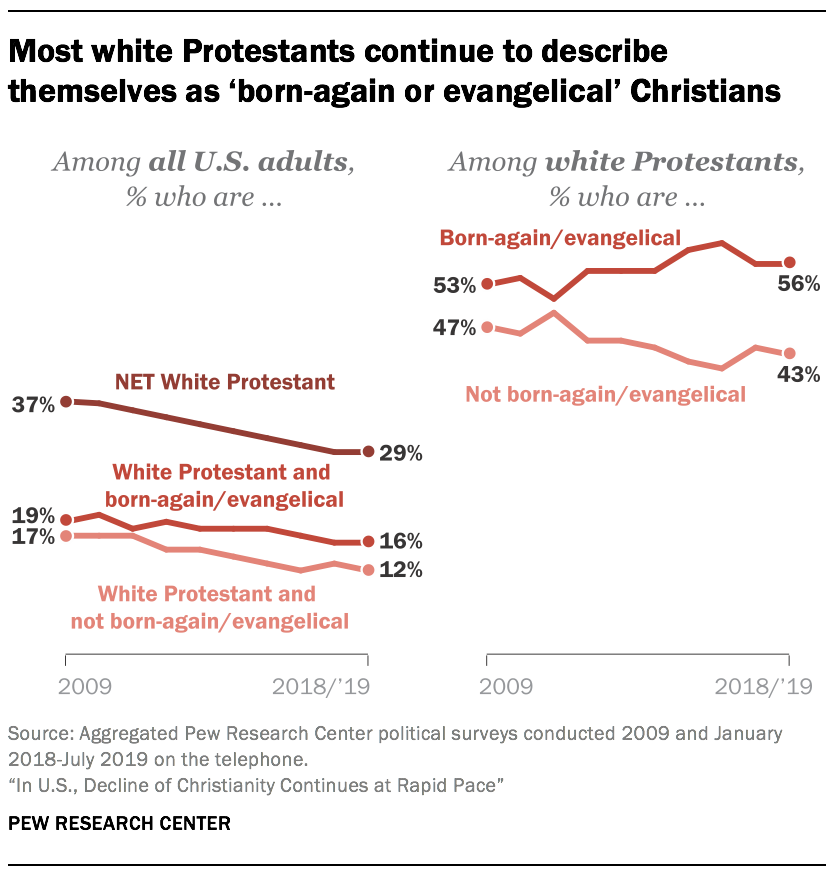 The share of U.S. adults who are white born-again or evangelical Protestants now stands at 16%, down from 19% a decade ago. The shrinking white evangelical share of the population reflects both demographic changes that have occurred in the United States (where white people constitute a declining share of the population) and broader religious changes in American society (where the share of all adults who identify with Christianity has declined). However, looking only at white Protestants – rather than at the public as a whole – the share of white Protestants who describe themselves as born-again or evangelical Christians is at least as high as it was a decade ago.
The share of U.S. adults who are white born-again or evangelical Protestants now stands at 16%, down from 19% a decade ago. The shrinking white evangelical share of the population reflects both demographic changes that have occurred in the United States (where white people constitute a declining share of the population) and broader religious changes in American society (where the share of all adults who identify with Christianity has declined). However, looking only at white Protestants – rather than at the public as a whole – the share of white Protestants who describe themselves as born-again or evangelical Christians is at least as high as it was a decade ago.
For complete information about trends in the religious composition and worship attendance habits of the U.S. public, see detailed tables.


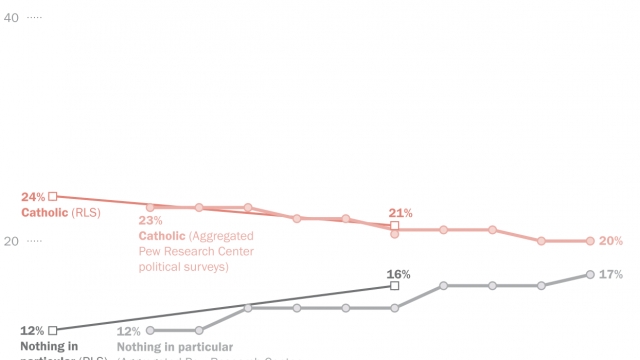
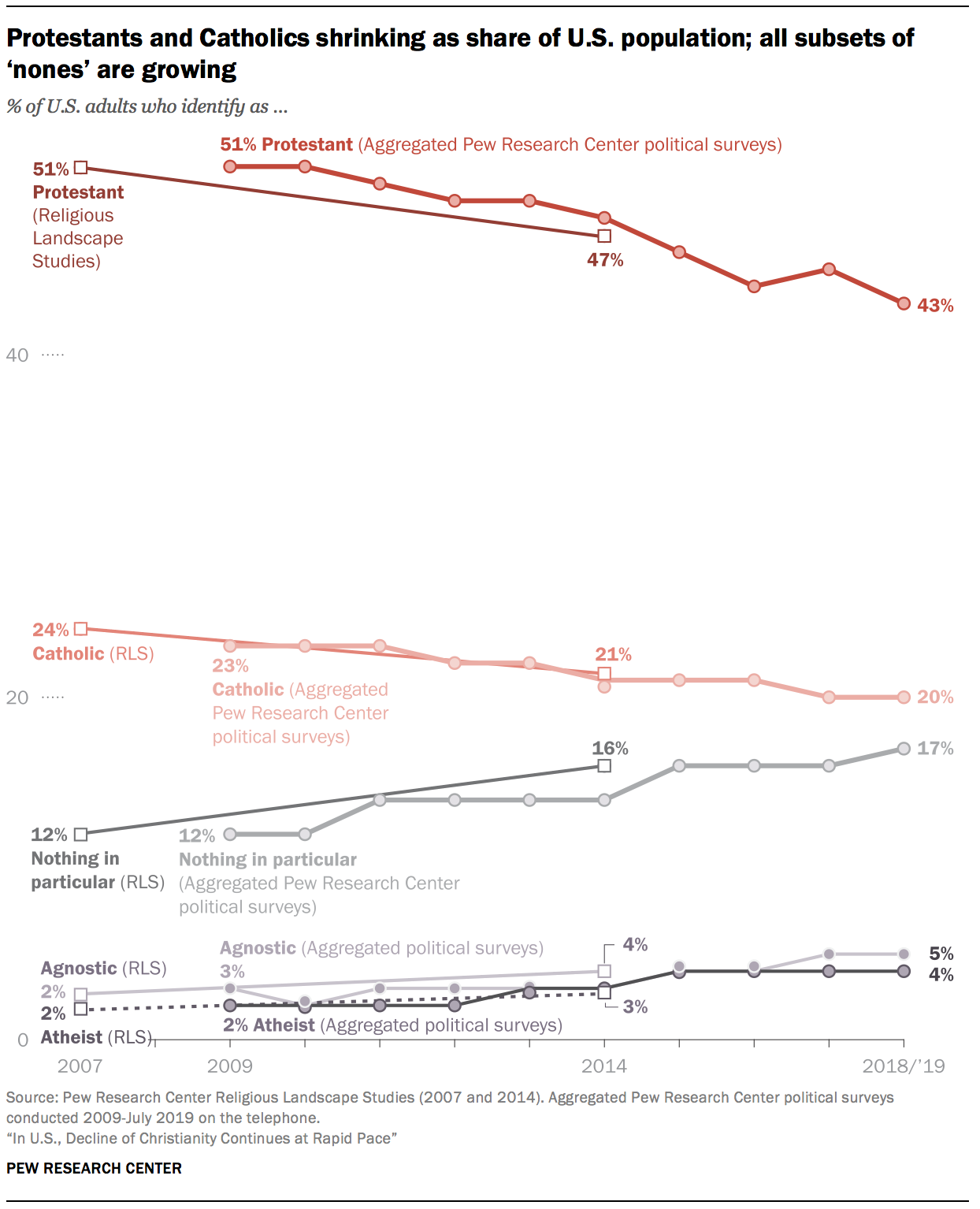

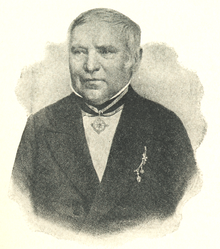
Varnel Watson
oh NO Daniel J Hesse Joe Absher Jim Price
Richard Shelton
How do we know this to be true?!
Joe Absher
Have you been to church lately? the majority of the sermons are hearsay without any eternal weight or merit
Varnel Watson
Richard Shelton do you have a reason to question PEW’s recent report? It is a statistical study consistent with the reports of the largest Pentecostal organizations including our AoG which has been in a steady decline since the reported 2017 revival
Craig King
I personally feel like God is on the move in the US at this moment, and in a gigantic Godly way. I feel a shift in the platforms of influence in the US. Revival is on its way.
Varnel Watson
we’ve been hearing this for many years now Craig King as a matter of fact our AG claimed its the only denomination growing No such claims have been made for the past 2-3 yrs anymore Even among the baptists LifeWay is closing in 2019 Revival does not translate in church growth all the time, but why are the stats showing decline?
Craig King
Troy Day , I don’t doubt the statistics. I think that over the last decade, there has been more and more youth events (sporting, theatrical, academic, etc.) that are scheduled on Sundays. This has contributed to the decline.
The buzz that I am feeling lately comes from encounters I have had recently. Their is a curiosity that is building in the secular domain. Questions are increasingly being asked about who Jesus is.
So for me, I don’t doubt the decline, but I have hope in what’s to come.
Varnel Watson
Craig King I ministered in WV right before the long youth revival started there a few year ago Then there was almost 30-long revival with a tent close to our area following I have not heard neither of these along with many others to contribute to church growth and as a matter of fact seems like mode declined has happened in just the past 5 yrs than ever before in America Not sure what buzz you got….
Varnel Watson
OK Peter Vandever this is the actual PEW stats from NOV 19 I think only Daniel J Hesse who remembers sometimes in 2018 I stated the AG was declining WELL everyone was still on the 2017 hype which was basically AG international growth nothing in the US
Some guy here Phil Max or similar claimed their AG church was growing fast/ In NEW MEXICO we know how fast AG grows there SO after checking he was not actual AG but some new church plant which was merging local churches and was trying to associate with AG but were too alternative for themselves
we know how fast AG grows there SO after checking he was not actual AG but some new church plant which was merging local churches and was trying to associate with AG but were too alternative for themselves
Your map is also OLD – as old as the evangelists youve seen on their NOT updated page As most of them are I have not seen NO new map since 2017 And the official stats on the AG official central HQ site has 2018 stats and very little 2019
about your previous post or 2 that I just read somewhere but cant find now… I could not find the link to the AG article you pointed to HOWEVER the discussion on the false AG growth stats is taken DIRECTLY from our website
Back when the 2017 AG growth boom was in the news we did a dozen of stat articles and discussions looking into it The series showed the growth was OUTSIDE of the US mainly international churches that are part of the fellowship but are not really AG Springfield – more of a grass root growth type of thing rather than denominational strategy
We further we able to foresee in the discussions that AG will stop the acclaimed growth within 1-2 yrs or basically their research cycle time frame And so it happened Just look at their 2019 stats where they have 300 more churches closing than opening per capita You can dig the discussions and check them out from the archive We had some ppl from the West joining in, several regional superintedants authors of AG fundamental documents like Resolution 16 and others joining who at the end had to admit Growth was international and was no more
AG’s response on the stats was expected as our discussions reached Springfield and further. Guess they were read at a higher level than we anticipated at first. The response was loosely based on a fragment study done by a well known Eastern European theologian who showed 25 year revival cycles taking place in EU Pentecostalism His theoretix was taken and applied to the US AG but obviously by 2019 the stats show sudden decline in churches. I am not sure HOW the rest of the church stats were taken as conversion was nowhere defined in the stats, infilling with the Spirit was counted with or without speaking in tongues and AG does not report sanctification so when they say MEMBERSHIP that reflects ppl taken into the church NOT newly saved/converted or disciplined…
AG stopped growing with the FL revivals
the manuals on how to have revivals really hurt them
Gary Micheal Epping said he never saw them but here they are on the PDF link – – –
One of the authors of resolution 16 shared it
Res 16 stopped the apostolic prophetic in AG
Res 16 around 2000 forecaster the decline in the next 15 yrs
http://www.pentecostaltheology.com/a-biblical-critique-of-brownsville-assembly-of-god-deliverance-manual/ OK long comment BUT there is even more later …
Daniel J Hesse
Troy Day I am so glad we’re sanctified and illuminated. It has helped us in the AG to get a new General Secretary Donna Barrett. I believe she is calling for accountability.
Varnel Watson
Daniel J Hesse sometimes wonder when Dan Brent says its a long long process for them
Dan Brent
What now?
Daniel J Hesse
Dan Brent long long process?
Dan Brent
Daniel J Hesse: I’ve been digging into some Hollis Gause lately, so I’m more engaged in the instantaneous camp right now. LOL
Daniel J Hesse
Dan Brent I am still a proponent of the progressive perspective. I battle my regressive nature.
Only Sanka is instant. I have oft wondered if G. Campbell Morgan held our fundamentalist understanding if sanctification?
Daniel J Hesse
Dan Brent Hollis Gause?
Dan Brent
Daniel J Hesse https://www.amazon.com/Living-Spirit-Salvation-Hollis-Gause-ebook/dp/B004C44NKS/ref=mp_s_a_1_4?dchild=1&keywords=hollis+gause&qid=1586481263&sr=8-4
Dan Brent
First dean at the CofG’s Cleveland seminary
https://en.m.wikipedia.org/wiki/Rufus_Hollis_Gause
Varnel Watson
Dan Brent why are you hijacking this post too? Are you saying the decline in evangelicals is because they lack sanctification?
Daniel J Hesse
Troy Day it may be possible. The elders preached separation from the world…
Dan Brent
Troy Day: You said I said it’s a “long long process.” I thought you were making a joke about my posts on sanctification, so I was playing along.